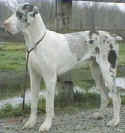|
Perianal Fistulas
In Fond and Loving Memory of Scarlett, Duke, and
Cameron.
Perianal Fistulas AKA Anal Furunculosis is a disease encountered most frequently
in German Shepherds, but also found in Great Danes and all other
breeds on occasion. It is characterized by
chronic infection and ulceration of the tissues around the anus. More
importantly, there are often unseen, but deeply infiltrating, fistulous
tracts which run under the skin and along the rectal wall up to 3 and 4
inches deep.
While the exact cause of the disease is unknown,
some German Shepherds seem to be unable
to resist even superficial infections which may occur on and in the skin. This
may be the result of an ineffective immune response resulting in
predisposition to the development of skin infections as a persistent
problem. Also, the conformation of the German Shepherd allows
for the broad base of the tail to remain in almost continual contact
with the anus, thereby spreading a thin film of feces over the perianal
area. This is the area which is affected most frequently. Recent
evidence, points to an immune-mediated process as the
underlying cause of this disease.
The anal sacs are usually involved in the disease and are removed as
part of the treatment. It should also be known that a
dogs predisposition to the development of Perianal Fistulas is
lifelong. Relapses, may sometimes occur even after
apparent cure.
Symptoms: The primary lesions
are deep, draining, openings around the anus which will not
heal. They may spread to involve a large portion of the perianal area.
Many dogs with perianal fistulas will show few signs of discomfort apart
from licking the anal area, but in advanced cases there may be damage
and scarring which prevents normal passing of feces. These dogs may experience
constipation and extreme pain when passing feces. Other dogs with severe
perianal fistulas may not be able to close the anus properly and become
incontinent.
Treatment: No single technique
has been shown to result in a cure for perianal fistulas.
Surgical removal of the infected tissue followed by
reconstruction of the surrounding skin has met with fair results. The
key to success is to resolve the chronic, deep, fistulous drainage while
maintaining fecal continence. The damage to the anal sphincter from the
deep fistulas determines fecal continence, its preservation is
of great importance to the surgeon. Many dogs will need more then
one surgery.
It is very
important that they are examined regularly until complete resolution of
the tracts has occurred. When a second surgery is required, its purpose
is to remove the smaller, perianal fistulas and, minimize the chance of recurrence.
Unfortunately, a percentage of dogs will
not respond to surgery and will continue to have
problems or incontinence. These are often identified during the initial
examination and are named high risk patients prior to treatment.
For more information concerning this disease or
support please visit
Perianal Fistulas
Information Site.
  
Scarlett Camron Duke
All images and text on this site Copyright © 1998-2025 Harlequin Haven Great Dane Rescue, Inc. unless otherwise credited. Use of any image or text without written permission is expressly forbidden. All rights reserved.
|



